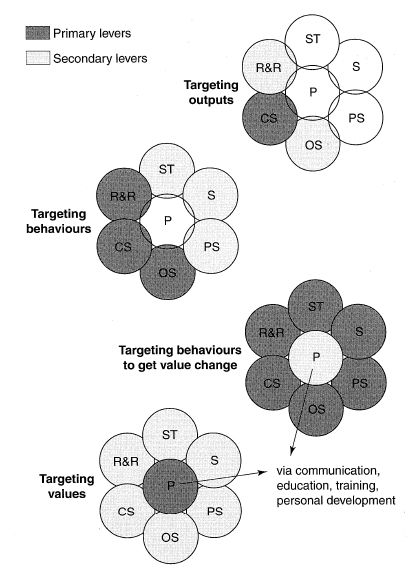
Elements of The Change Kaleidescope:
Organisational Change context: Time, Scope, Preservation, Diversity, Capability, Capacity, Readiness, Power
Design choises: Change path, Change start point, Change style, Change target, Change roles, Change levers
Principle:
The components in Organisational Change context, and the six Design/implementation choises
Types of change: (Path when forming series of types)
Targeting outputs, Targeting behaviours, Targeting behaviours to to get value change, Targeting values (See next figure)
Change start point:
Top down, Bottom up, Pilots, Pockets of Best Practice
Change Style:
Education&communication, Collaboration, Participation/intervention, Direction, Coercion
Change Target:
Values (hard to change personal), Behaviour (see below), Outputs (new performance measures), Roles (leadership, external agent, action team , functional)
(Beer, Eisenstat, Spector, 1990)
Change Levers:
Cultural WEB – (Johnson & Scholes, 1999)

Issues:
Realignment (Adaptation: new IT system Cost cut: reconstruction)
Transformation
- Incremental: customer focus or commercial business man vs technical competence
- Revolution: hard to achieve (resource, skill, finance)
| Style | Description | Advantages | Disadvantages |
| Education and communication | Use small group briefings to discuss things with people and explain things to them. The aim is to gain support for change by generating understanding and commitment. | Spreads support for change. Also ensures a wide base of understanding. | Takes a long time. If radical change is needed, fact-based argument and logic may not be enough to convince others of need for change. Easy to voice support, then wlak away and do nothing. |
| Collaboration | Widespreadinvolvement of the employees on decisions about what and how to change. | Spreads not only support but ownership of change by increasing levels of involvement. | Time consuming. Little control over decisions made. May lead to change within paradigm. |
| Participation/ intervention | Consultation of employees on decisions about how to deliver the desired changes. May also include limited collaboration over aspects of the “how to” of change as opposed to the “what” of change. | Again, spreads ownership and support for change, but with a more controlled framework. Easier to shape decisions. | Can be perceived as minipulation. |
| Direction | Change leaders make the majority of decisions about what to change and how. Use of authority to direct change. | Less time consuming. Provides a clear change of direction and focus. | Potentially less support and commitment, and therefore proposed changes may be resisted. |
| Coercion | Use of power ti impose change. | Allows for promt action. | Unlikely to achieve buy-in without a crisis. |
Change of structure to change individuals as roles and tasks constrains behaviour (see change target):
| Programmatic change | Task alignment |
| Problems in behaviour result from individual knowledge, attitudes and beliefs | Individual attitudes and beleifs are shaped by recurring patterns of behavioural interactions. |
| The primary change target should be attitudes – actual behaviour should be secondary | The primary change target should be behaviour – attitudes should be secondary. |
| Behaviour can be isolated and changed individually | Behavioural problems come from the roles individuals are in – the impact of the organisational system on the individual are greater than the impact of the individual on the system. |
| Therefore… | |
| The change target should be at an individual level. | The change target should be at the organisational level – changing roles, responsibilities and relationships. |
Applications:
Choices to consider in change implementation
Source of The Change Kaleidescope:
(Balogun & Hope Hailey, 1999)






